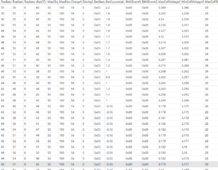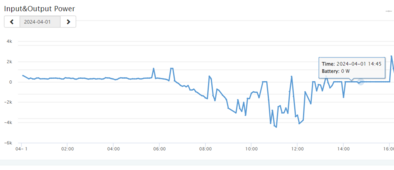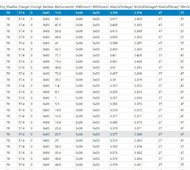silverstone
Solar Enthusiast
- Joined
- May 3, 2022
- Messages
- 1,041
I'll actually wait a bit now just to not create another issue on GitHub for nothing .... If I set the charge_v_factor_setting to 3.0 it seems somewhat more stable.Yes please.
Keep in mind 180A (well 200A) is for both batteries: the smart one running the communication with the inverter, and the "dumb" one (only reporting to MQTT/HA).If you are charging at a higher C rate (which a max of 180A would suggest) then yes, charge_v_factor_setting can be set to be more aggressive.

I think I'll open an issue after all. It's "ringing" (oscillating) quite a lot near the top of the charge ... Both the requested charge voltage, the requested battery voltage and the actual charge current@MrPablo: Actually I take it back. The default value of 2.0 didn't work at all for me (it actually went "full" power and caused cell 11 to hit OVP as usual).
When charge_v_factor = 3.0 instead it seems to work WONDERS.
So ... conclusions ... if there is no BMS communication or the current doesn't taper off when one cell is near OVP, then that will overcharge and recharging the other ones via the active balancer will take forever. Not sure why the overcharged cell comes back A LOT, then needs to rise again though.
Now all of them are above 3.42VDC so it should not take much. So in terms of Ah, it was NOT a huge unbalance:
View attachment 205074
Yesterday I think I brought up the lowest ones from 3.36VDC to 3.39VDC.
I think once the pack will be (re)balanced, it will be much more "normal" (provided that the voltage control works).
I'm still thinking there is something quite off with the active current control, but that's probably because I am forcing a top balance WELL ABOVE float of 53.6 V. Hence I decided to disable it, at least for now.
I cant wait to test your solution, this is one i have been waiting for...Hi @silverstone and Mr. Pablo, why dont you try map(maxcellvoltage, UVP-50, UVP + 10, Max_charge_current, 0) I tested with this and it working sound okay! Will test tomorrrow a bit more on this!
Hi @paulsteigel, the existing auto charge current control does similar to this already.Hi @silverstone and Mr. Pablo, why dont you try map(maxcellvoltage, UVP-50, UVP + 10, Max_charge_current, 0) I tested with this and it working sound okay! Will test tomorrrow a bit more on this!
My Inverter prefer fix charge voltage. I observed some dedicated BMS shipped with whole pack of high quality battery over months connected to the inverter via Rs485 and it only applies a single voltage 56V during the charging and sometime does resetting SOC by trying to lengthen the charging process to make cell be as close to 3.45 as better. Over a year, I could hardly see the min cell voltage drop below 3.1V and few time discovered the max voltage reach 3.46.Hi @paulsteigel, the existing auto charge current control does similar to this already.
At the moment, we're working on controlling charge current through dynamically adjusting the requested CVL. That's the more effective way to do it, assuming your inverter regulates CVL properly...



Now that you have mentioned, I too have a Luxpower SNA 5000 and everything is working for me at my end for months. Let me know what settings are you using and what version specifically.So I doubt there would be problem relating to the reporting of charging voltage from BMS (CAN_ID 0x356) or (CAN_ID 0x351). I discussed with Luxpower Dealer on this point but he failed to explain (he might not know about this).
Yap, it was very strange as the code worked (the Mr.Pablo one) on the SNA6K version, but the same code failed on the SNA5000. I tried a few options but it was too late, no more solar today. Will try tomorrow on 0x356 and 0x351 to report lower voltage for checking what has happened!Now that you have mentioned, I too have a Luxpower SNA 5000 and everything is working for me at my end for months. Let me know what settings are you using and what version specifically.
You are totally right! That is why we are here with Pablo and other working hard to find a solution for this! What we are doing is making the JK work better as we can expect it to function perfectly! I myself believe current limit and voltage limit are two feasible options then!Also, if it bears mentioning again and again. When there is current going in/out of the battery, its balance can't be determined due to internal resistance.
Very Ideally, determining battery balance involves removing all external potentials across the battery (such as can be achieved by turning BMS Charge MOS off) and letting the cells rest for like half an hour or so.
Then the voltage measured of the cells will correspond to the true balance voltages. Theoretically, this is also the ideal time for a balancer to do its job. after a full charge with no current going in/out, and no external potential to affect voltage readings.
Everything else is a compromise, loosely speaking.
your battery brand setting?Yap, it was very strange as the code worked (the Mr.Pablo one) on the SNA6K version, but the same code failed on the SNA5000. I tried a few options but it was too late, no more solar today. Will try tomorrow on 0x356 and 0x351 to report lower voltage for checking what has happened!
on JK OVP is 3.55V, current limit for charge 100A, discharge 100A but I have addition layer of limits on esphome with max_cell_protection of 3450mV and Charge current limit of 70A. On SNA, Charge limit is 100A but it listened to the BMS via CAN, Voltage was 57.4 (default set for lead acid and still kept as it is). Lux stop charging at some period and reported W025 - Battery High voltage). He changed to lead acid and charge went well without problem. Haiza - this is headache. This did not happen with another guy usign SNA6K. He even push the current to almost 80Ayour battery brand setting?

I used PYLON - select brand 2 on SNA5000WMNot on JK, I'm asking specifically what CAN protocol you are using in YAML script dashboard
AND
What battery brand under lithium battery you are using in your LXP SNA 5k?
View attachment 206256
57.4v is a high charge voltage assuming a 16s battery. General guidance is to bulk charge at 3.45v per cell, so 55.2v.on JK OVP is 3.55V, current limit for charge 100A, discharge 100A but I have addition layer of limits on esphome with max_cell_protection of 3450mV and Charge current limit of 70A. On SNA, Charge limit is 100A but it listened to the BMS via CAN, Voltage was 57.4 (default set for lead acid and still kept as it is). Lux stop charging at some period and reported W025 - Battery High voltage). He changed to lead acid and charge went well without problem. Haiza - this is headache. This did not happen with another guy usign SNA6K. He even push the current to almost 80A
View attachment 206255


